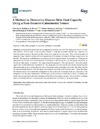Identificador persistente para citar o vincular este elemento:
https://accedacris.ulpgc.es/handle/10553/73551
| Campo DC | Valor | idioma |
|---|---|---|
| dc.contributor.author | Rodriguez De Rivera Socorro, Pedro Jesús | en_US |
| dc.contributor.author | Rodríguez de Rivera, Miriam | en_US |
| dc.contributor.author | Socorro, Fabiola | en_US |
| dc.contributor.author | Rodríguez de Rivera, Manuel | en_US |
| dc.contributor.author | Marrero Callicó, Gustavo | en_US |
| dc.date.accessioned | 2020-06-29T14:41:02Z | - |
| dc.date.available | 2020-06-29T14:41:02Z | - |
| dc.date.issued | 2020 | en_US |
| dc.identifier.issn | 1424-8220 | en_US |
| dc.identifier.other | Scopus | - |
| dc.identifier.uri | https://accedacris.ulpgc.es/handle/10553/73551 | - |
| dc.description.abstract | A calorimetric sensor has been designed to measure the heat flow dissipated by a 2 x 2 cm2 skin surface. In this work, a non-invasive method is proposed to determine the heat capacity and thermal conductance of the area of skin where the measurement is made. The method consists of programming a linear variation of the temperature of the sensor thermostat during its application to the skin. The sensor is modelled as a two-inputs and two-outputs system. The inputs are 1) the power dissipated by the skin and transmitted by conduction to the sensor, and 2) the power dissipated in the sensor thermostat to maintain the programmed temperature. The outputs are 1) the calorimetric signal and 2) the thermostat temperature. The proposed method consists of a sensor modelling that allows the heat capacity of the element where dissipation takes place (the skin) to be identified, and the transfer functions (TF) that link the inputs and outputs are constructed from its value. These TFs allow the determination of the heat flow dissipated by the surface of the human body as a function of the temperature of the sensor thermostat. Furthermore, as this variation in heat flow is linear, we define and determine an equivalent thermal resistance of the skin in the measured area. The method is validated with a simulation and with experimental measurements on the surface of the human body. | en_US |
| dc.language | eng | en_US |
| dc.relation.ispartof | Sensors | en_US |
| dc.source | Sensors (Switzerland) [ISSN 1424-8220], v. 20 (12), 3431, (Junio 2020) | en_US |
| dc.subject | 33 Ciencias tecnológicas | en_US |
| dc.subject.other | Direct Calorimetry | en_US |
| dc.subject.other | Heat Capacity | en_US |
| dc.subject.other | Heat Conduction Calorimeters | en_US |
| dc.subject.other | Human Skin | en_US |
| dc.subject.other | Medical Calorimetry | en_US |
| dc.subject.other | Thermal Resistance | en_US |
| dc.title | A method to determine human skin heat capacity using a non-invasive calorimetric sensor | en_US |
| dc.type | info:eu-repo/semantics/Article | en_US |
| dc.type | Article | en_US |
| dc.identifier.doi | 10.3390/s20123431 | en_US |
| dc.identifier.scopus | 85086753067 | - |
| dc.identifier.scopus | 85086603863 | - |
| dc.contributor.authorscopusid | 57200590110 | - |
| dc.contributor.authorscopusid | 57202152954 | - |
| dc.contributor.authorscopusid | 6603271349 | - |
| dc.contributor.authorscopusid | 55665096500 | - |
| dc.contributor.authorscopusid | 56006321500 | - |
| dc.contributor.authorscopusid | 57202461878 | - |
| dc.contributor.authorscopusid | 57202465692 | - |
| dc.contributor.authorscopusid | 6506079738 | - |
| dc.description.lastpage | 19 | en_US |
| dc.identifier.issue | 12 | - |
| dc.description.firstpage | 1 | en_US |
| dc.relation.volume | 20 | en_US |
| dc.investigacion | Ciencias | en_US |
| dc.type2 | Artículo | en_US |
| dc.utils.revision | Sí | en_US |
| dc.date.coverdate | Junio 2020 | en_US |
| dc.identifier.ulpgc | Sí | en_US |
| dc.description.sjr | 0,636 | |
| dc.description.jcr | 3,576 | |
| dc.description.sjrq | Q2 | |
| dc.description.jcrq | Q2 | |
| dc.description.scie | SCIE | |
| item.grantfulltext | open | - |
| item.fulltext | Con texto completo | - |
| crisitem.author.dept | GIR Termofísica de Líquidos y Calorimetría | - |
| crisitem.author.dept | Departamento de Física | - |
| crisitem.author.dept | GIR Termofísica de Líquidos y Calorimetría | - |
| crisitem.author.dept | Departamento de Física | - |
| crisitem.author.dept | GIR Termofísica de Líquidos y Calorimetría | - |
| crisitem.author.dept | Departamento de Física | - |
| crisitem.author.dept | GIR IUMA: Diseño de Sistemas Electrónicos Integrados para el procesamiento de datos | - |
| crisitem.author.dept | IU de Microelectrónica Aplicada | - |
| crisitem.author.dept | Departamento de Ingeniería Electrónica y Automática | - |
| crisitem.author.orcid | 0000-0002-6343-6683 | - |
| crisitem.author.orcid | 0000-0002-4890-5947 | - |
| crisitem.author.orcid | 0000-0002-6737-4096 | - |
| crisitem.author.orcid | 0000-0002-3784-5504 | - |
| crisitem.author.parentorg | Departamento de Física | - |
| crisitem.author.parentorg | Departamento de Física | - |
| crisitem.author.parentorg | Departamento de Física | - |
| crisitem.author.parentorg | IU de Microelectrónica Aplicada | - |
| crisitem.author.fullName | Rodríguez De Rivera Socorro, Pedro Jesús | - |
| crisitem.author.fullName | Socorro Lorenzo, Fabiola Lourdes | - |
| crisitem.author.fullName | Rodríguez De Rivera Rodríguez, Manuel Jose M. | - |
| crisitem.author.fullName | Marrero Callicó, Gustavo Iván | - |
| Colección: | Artículos | |
Citas SCOPUSTM
1
actualizado el 08-jun-2025
Citas de WEB OF SCIENCETM
Citations
6
actualizado el 08-jun-2025
Visitas
168
actualizado el 04-ene-2025
Descargas
128
actualizado el 04-ene-2025
Google ScholarTM
Verifica
Altmetric
Comparte
Exporta metadatos
Los elementos en ULPGC accedaCRIS están protegidos por derechos de autor con todos los derechos reservados, a menos que se indique lo contrario.
